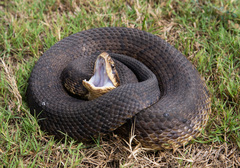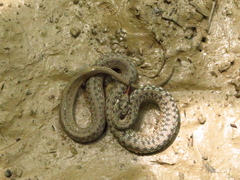
Snake

About
How to know if you have snakes
There are certain places where snakes may be more likely to hide on your property.
- Reptile habitats - Nature reserves of rough grassland, disused quarries, large allotments, large derelict urban sites, or sunny road and railway embankments with scrub cover
Garden features - Wood, rock or rubble piles, rockeries, ponds, long grass areas and shrubs
Sunny areas - Suntrap areas with lots of vegetation cover and places to shelter
Gardens, parks or other grassed areas - Under debris or are near features such as hedges, ponds, compost heaps and areas of long grass
Snakes like to hide, so you may not know they are around until you actually see them. Snakes shed their skins several times a year, so one of the first signs might be the shed skins they leave behind. If your business is in a dusty area or has a lot of dirt around, you might also see twisted trails from where they slithered by.
How to keep snakes away from your business
- How ‘snake proof’ is your business? Are you aware that a snake, particularly the thinner ones, can get into your commercial property through a gap the size of a pen or pencil – as can a mouse!
- Also, remember that some snakes can swim and climb so carefully inspect the exterior and interior of your building. A Rentokil Specialist can inspect your premises and advise you on proofing against entry by snakes.
'Proof' your business against snakes
Here are some things to look for when inspecting your property:
Do you have screens on your windows and doors? Are there gaps around the frame or holes in the actual screening?
Do you have any gaps under doors? If so, weather stripping can be an effective way to seal these.
Are there holes, cracks or crevices in the brick or plasterwork of your building?
Are there any holes, cracks or crevices between patio areas or pathways and your property? Drainage areas in patios are a perfect point of entry.
Is the gauge size of your drain grates small enough to stop snakes from entering?
Take these steps to prevent snakes from entering your business:
Make sure that there are no holes in the roof through which snakes can enter - particularly if trees overhang the building.
Ensure baseboards do not have gaps under or behind them.
Seal all holes where wiring, plumbing or gas enters your business.
Cover gutters and drain pipes with fine-gauge mesh.
If your business has wooden floorboards ensure that access to the floor space beneath them is sealed and that gaps between the boards themselves are filled.
Long grass is a favored habitat of snakes so keep the landscaping around your property well maintained.
Keep shrubs trimmed around their base and away from the walls of your facility.
Ensure that tree branches do not cover your property or seating areas around your business.
Regularly sweep up leaves and other debris on your property.
Install solid wooden decking in seating areas (rather than slatted) to prevent snakes from climbing through it.
Keep garbage and compost in sealed receptacles to keep potential snake prey like rats and mice out.
Agkistrodon piscivorus
Agkistrodon contortrix
Micrurus tener
Western Diamondback Rattlesnake 2
Crotalus atrox
Crotalus horridus
Sistrurus miliarius
Pantherophis obsoletus
Nerodia erythrogaster
Nerodia rhombifer
Nerodia fasciata confluens
Haldea striatula
Storeria dekayi
Thamnophis proximus
Heterodon platirhinos
Opheodrys aestivus
Lampropeltis holbrooki
Coluber flagellum testaceus
Eastern Yellow-bellied Racer 3
Coluber constrictor flaviventris
Regina grahamii
Lampropeltis calligaster calligaster
Liodytes rigida
Lampropeltis gentilis
Farancia abacura






















